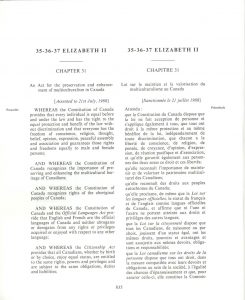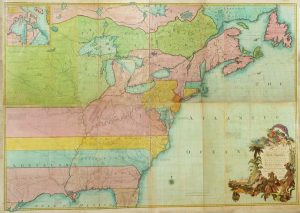2. In this lesson I say that it should be clear that the discourse on nationalism is also about ethnicity and ideologies of “race.” If you trace the historical overview of nationalism in Canada in the CanLit guide, you will find many examples of state legislation and policies that excluded and discriminated against certain peoples based on ideas about racial inferiority and capacities to assimilate. – and in turn, state legislation and policies that worked to try to rectify early policies of exclusion and racial discrimination. As the guide points out, the nation is an imagined community, whereas the state is a “governed group of people.” For this blog assignment, I would like you to research and summarize one of the state or governing activities, such as The Royal Proclamation 1763, the Indian Act 1876, Immigration Act 1910, or the Multiculturalism Act 1989 – you choose the legislation or policy or commission you find most interesting. Write a blog about your findings and in your conclusion comment on whether or not your findings support Coleman’s argument about the project of white civility.
For this assignment, I decided to investigate the 1989 Canadian Multiculturalism Act. I was intrigued by this policy in particular because the BNA Act, Indian Act, and Immigration Act were all produced in a comparatively distant time period, which, although it does not lessen the horror of their implications and approaches, can seem cognitively distant enough that individuals attempt to tell themselves the governments that enacted those policies do not resemble ours and were more malicious than ours, which to me becomes dangerously close to the attitude of “that couldn’t happen here” or “that couldn’t happen now” that leads to individuals becoming complacent within their own democracies. In contrast, the Multiculturalism Act is relatively recent (occurring within the past 50 years), and at least on the surface level, seems far more positive in its approach to crafting a national identity than the BNA Act or the Indian Act, who explicitly attempt to control non-white groups and embrace colonial settlers as the dominant group.
The Canadian Multiculturalism Act of 1989 emerged in response to shifting social policies and opinions that worked to recognize the rights of various minority groups; in the 1960’s and 1970’s, this social movement included social forces like the Civil Rights movements in Canada and the US, the first and second wave feminist movements, and within Canada, Quebec’s Quiet Revolution. By 1989, an increasingly diverse Canadian population that grew with the help of immigration reform prioritizing skilled labour over country of origin began to fight for recognition by the Canadian government. Although general attitudes were becoming more inclusive, there was still little to no legal framework entrenching multiculturalism as a national value or as a legal framework through which to guide lawmakers and businesses.
However, while entrenching multiculturalism may initially seem like a positive action, recently questions have been raised about whether this action instead just identifies a sense of culturalism that relegates individual’s to their country or culture of origin, their observable heritage, or their families ethnic and cultural roots. This not only has the potential to emphasize cultural differences instead of similarities and empathy but also fails to identify the intersections or complexities of an individual’s upbringing. For example, how do you classify the culture of someone who had one parent grow up in France, the other in Kenya, both of whom then attended post-secondary in, say, England, before moving to Canada and raising a child together? (For an excellent discussion on this topic, and an alternative to asking ‘where are you from?’, see this video). There are many ways cultures intersect and diverge from the country of origin, and many cultures whose worldview does not center around borders, like the Indigenous people of Canada, whose presence in this land precedes even the concept of the nation-state.
Within the context of Coleman’s argument about creating a narrative of white civility, the fact that existing documentation was founded on a view of Canadian identity that was primarily limited to English and French in its recognition demonstrates the ways in which systematic frameworks were designed with whiteness as the priority. Similarly, the modifications to encourage diversity and inclusion through the Multiculturalism Act shows the disparities existing in the way minority and majority groups were treated; an explicit program to encourage diversity is necessary only in the backdrop of discrimination, and the ways in which this act identified minority groups further solidified this divide.

Library and Archives Canada. Statutes of Canada. An Act for the Preservation and Enhancement of Multiculturalism in Canada, 1988, SC 36-37 Elizabeth II, Volume I, Chapter 31. Retrieved from “Canadian Multiculturalism Act, 1988”.
Works Cited
“Canadian Multiculturalism Act, 1988.” Canadian Museum of Immigration at Pier 21, 2019, pier21.ca/research/immigration-history/canadian-multiculturalism-act-1988. Accesed 26 Feb 2019.
Dirks, Gerald. “Immigration Policy in Canada.” The Canadian Encyclopedia, 29 Jun 2017, thecanadianencyclopedia.ca/en/article/immigration-policy. Accessed 27 Feb 2019.
“Nationalism, 1960s onwards: Multiculturalism.” CanLit Guides, Canadian Literature Quarterly, 4 Oct 2016, canlitguides.ca/canlit-guides-editorial-team/nationalism-1960s-onwards-multiculturalism/. Accessed 26 Feb 2019.
“The Quiet Revolution.” Canada History, 2013, canadahistory.com/sections/eras/cold%20war/Quiet%20Revolution.html. Accessed Feb 26 2019.
Selasi, Taiye. “Don’t ask where I’m from, ask where I’m a local.” TEDGlobal, 2014, ted.com/talks/taiye_selasi_don_t_ask_where_i_m_from_ask_where_i_m_a_local/details?referrer=playlist-what_is_home&language=en. 26 Feb 2019.



